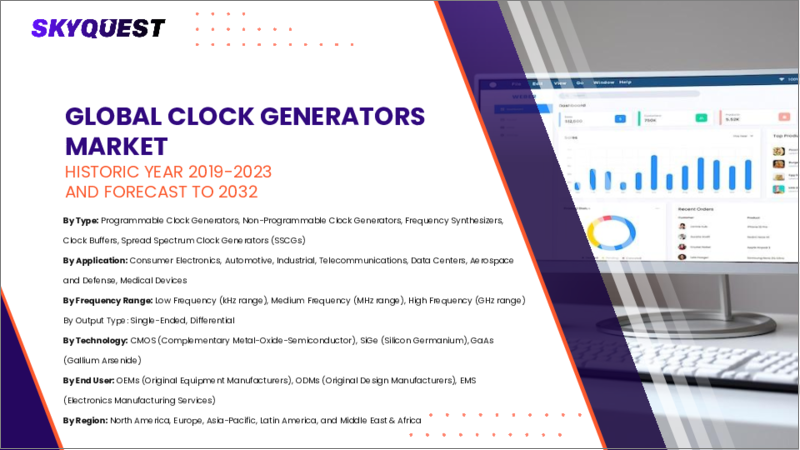|
|
市場調査レポート
商品コード
1673615
クロックジェネレーター市場規模、シェア、成長分析:タイプ別、用途別、エンドユーザー別、地域別 - 産業予測 2025~2032年Clock Generators Market Size, Share, and Growth Analysis, By Type (Spread Spectrum Clock Generators, Programmable Clock Generators), By Application (Consumer Electronics, Automotive), By End-User, By Region - Industry Forecast 2025-2032 |
||||||
|
|||||||
| クロックジェネレーター市場規模、シェア、成長分析:タイプ別、用途別、エンドユーザー別、地域別 - 産業予測 2025~2032年 |
|
出版日: 2025年03月02日
発行: SkyQuest
ページ情報: 英文 197 Pages
納期: 3~5営業日
|
全表示
- 概要
- 目次
クロックジェネレーター2023年の市場規模は35億1,000万米ドルで、予測期間(2025-2032年)のCAGRは5.5%で、2024年の37億米ドルから2032年には56億8,000万米ドルに成長する見通しです。
クロックジェネレーターIC市場は、データセンター、通信、家電、自動車システムなど、さまざまな電子機器の機能において極めて重要な役割を果たしています。不可欠なコンポーネントとして、これらのICは電子システムのタイミングを同期させる不可欠なクロック信号を提供します。市場成長の原動力となっているのは、インターネットの普及と家電製品の複雑化に伴う、データ転送速度の向上と接続性の改善に対する需要の高まりです。複数のデータ標準をサポートできる高度なハードウェアには、高解像度のメディア共有や機能強化に対応する効率的なクロック生成が必要です。その結果、クロックジェネレーター市場は、より高速で効率的な電子操作のために信頼性が高く正確なタイミングソリューションを求める産業界によって、大幅な拡大が見込まれています。
目次
イントロダクション
- 調査の目的
- 調査範囲
- 定義
調査手法
- 情報調達
- 二次と一次データの方法
- 市場規模予測
- 市場の前提条件と制限
エグゼクティブサマリー
- 世界市場の見通し
- 供給と需要の動向分析
- セグメント別機会分析
市場力学と見通し
- 市場概要
- 市場規模
- 市場力学
- 促進要因と機会
- 抑制要因と課題
- ポーターの分析
主な市場の考察
- 重要成功要因
- 競合の程度
- 主な投資機会
- 市場エコシステム
- 市場の魅力指数(2024年)
- PESTEL分析
- マクロ経済指標
- バリューチェーン分析
- 価格分析
- ケーススタディ
- 規制情勢
- 技術分析
- 特許分析
クロックジェネレーター市場規模:タイプ別& CAGR(2025-2032)
- 市場概要
- スペクトラム拡散クロックジェネレーター
- プログラム可能なクロックジェネレーター
- 低ジッタークロックジェネレーター
クロックジェネレーター市場規模:用途別& CAGR(2025-2032)
- 市場概要
- 家電
- 自動車
- 産業
- 通信
- 医療機器
クロックジェネレーター市場規模:エンドユーザー別& CAGR(2025-2032)
- 市場概要
- OEM
- アフターマーケット
クロックジェネレーター市場規模:地域別& CAGR(2025-2032)
- 北米
- 米国
- カナダ
- 欧州
- ドイツ
- スペイン
- フランス
- 英国
- イタリア
- その他欧州地域
- アジア太平洋地域
- 中国
- インド
- 日本
- 韓国
- その他アジア太平洋地域
- ラテンアメリカ
- ブラジル
- その他ラテンアメリカ地域
- 中東・アフリカ
- GCC諸国
- 南アフリカ
- その他中東・アフリカ
競合情報
- 上位5社の比較
- 主要企業の市場ポジショニング(2024年)
- 主な市場企業が採用した戦略
- 最近の市場動向
- 企業の市場シェア分析(2024年)
- 主要企業の企業プロファイル
- 企業の詳細
- 製品ポートフォリオ分析
- 企業のセグメント別シェア分析
- 収益の前年比比較(2022-2024)
主要企業プロファイル
- Texas Instruments Incorporated(USA)
- Analog Devices, Inc.(USA)
- ON Semiconductor Corporation(USA)
- Renesas Electronics Corporation(Japan)
- Silicon Laboratories Inc.(USA)
- Microchip Technology Inc.(USA)
- STMicroelectronics(Switzerland)
- NXP Semiconductors(Netherlands)
- Maxim Integrated(USA)
- Cypress Semiconductor Corporation(USA)
- Integrated Device Technology, Inc.(USA)
- ROHM Semiconductor(Japan)
- Epson Corporation(Japan)
- Asahi Kasei Microdevices Corporation(Japan)
- Diodes Incorporated(USA)
- Silicon Motion Technology Corporation(Taiwan)
- Seiko Instruments Inc.(Japan)
- IQD Frequency Products Ltd(UK)
- Abracon LLC(USA)
- SiTime Corporation(USA)
結論と提言
Clock Generators Market size was valued at USD 3.51 billion in 2023 and is poised to grow from USD 3.7 billion in 2024 to USD 5.68 billion by 2032, growing at a CAGR of 5.5% during the forecast period (2025-2032).
The clock generator IC market plays a pivotal role in the functioning of various electronic devices, including data centers, telecommunications, consumer electronics, and automotive systems. As integral components, these ICs provide essential clock signals that synchronize the timing of electronic systems. Market growth is fueled by rising demands for higher data transfer rates and improved connectivity, driven by the proliferation of internet usage and the increasing complexity of consumer electronics. Advanced hardware capable of supporting multiple data standards requires efficient clock generation to handle high-resolution media sharing and enhanced features. Consequently, the clock generator market is poised for substantial expansion, as industries seek reliable, accurate timing solutions for faster and more efficient electronic operations.
Top-down and bottom-up approaches were used to estimate and validate the size of the Clock Generators market and to estimate the size of various other dependent submarkets. The research methodology used to estimate the market size includes the following details: The key players in the market were identified through secondary research, and their market shares in the respective regions were determined through primary and secondary research. This entire procedure includes the study of the annual and financial reports of the top market players and extensive interviews for key insights from industry leaders such as CEOs, VPs, directors, and marketing executives. All percentage shares split, and breakdowns were determined using secondary sources and verified through Primary sources. All possible parameters that affect the markets covered in this research study have been accounted for, viewed in extensive detail, verified through primary research, and analyzed to get the final quantitative and qualitative data.
Clock Generators Market Segments Analysis
Global Clock Generators Market is segmented by Type, Application, End-User and region. Based on Type, the market is segmented into Spread Spectrum Clock Generators, Programmable Clock Generators and Low Jitter Clock Generators. Based on Application, the market is segmented into Consumer Electronics, Automotive, Industrial, Telecommunications and Medical Devices. Based on End-User, the market is segmented into OEMs and Aftermarket. Based on region, the market is segmented into North America, Europe, Asia Pacific, Latin America and Middle East & Africa.
Driver of the Clock Generators Market
The clock generators market is experiencing significant growth, primarily fueled by the rising demand for consumer electronics like smartphones, tablets, and laptops. These modern devices rely on clock generators to ensure accurate synchronization among their various components, which include microprocessors, memory chips, and other integrated circuits. As consumer preferences shift toward more advanced and multifunctional gadgets, the necessity for reliable clock generation becomes increasingly critical, driving up the demand for these components. Consequently, the expanding electronics market is a key contributor to the ongoing expansion of the clock generators sector, reflecting the overarching trend in technological advancement and consumer needs.
Restraints in the Clock Generators Market
The growth of the clock generators market is hindered by various technical challenges that accompany the development of advanced clock generators. Key issues include managing noise levels, reducing power consumption, and addressing design complexity. Successfully navigating these challenges necessitates substantial investments in research and development efforts. As a result, the financial burden associated with overcoming these obstacles can restrict market expansion and innovation. Consequently, companies may find it difficult to bring new solutions to market efficiently, which can stifle overall growth in the clock generators sector and limit the introduction of cutting-edge technologies in this space.
Market Trends of the Clock Generators Market
The Clock Generators market is experiencing a significant upward trend, fueled by the burgeoning demand for high-speed connectivity and enhanced data transfer rates across various sectors, including telecommunications, automotive, and consumer electronics. As the need for precision timing signals intensifies, manufacturers are innovating advanced clock generators characterized by low jitter, minimal phase noise, and superior accuracy. This transition towards high-performance components aligns with the growing adoption of 5G technologies, IoT devices, and next-gen computing solutions, further propelling market expansion. Consequently, the Clock Generators market is poised for robust growth, driven by technological advancements and an increasing focus on reliability and efficiency.
Table of Contents
Introduction
- Objectives of the Study
- Scope of the Report
- Definitions
Research Methodology
- Information Procurement
- Secondary & Primary Data Methods
- Market Size Estimation
- Market Assumptions & Limitations
Executive Summary
- Global Market Outlook
- Supply & Demand Trend Analysis
- Segmental Opportunity Analysis
Market Dynamics & Outlook
- Market Overview
- Market Size
- Market Dynamics
- Drivers & Opportunities
- Restraints & Challenges
- Porters Analysis
- Competitive rivalry
- Threat of substitute
- Bargaining power of buyers
- Threat of new entrants
- Bargaining power of suppliers
Key Market Insights
- Key Success Factors
- Degree of Competition
- Top Investment Pockets
- Market Ecosystem
- Market Attractiveness Index, 2024
- PESTEL Analysis
- Macro-Economic Indicators
- Value Chain Analysis
- Pricing Analysis
- Case Studies
- Regulatory Landscape
- Technology Analysis
- Patent Analysis
Global Clock Generators Market Size by Type & CAGR (2025-2032)
- Market Overview
- Spread Spectrum Clock Generators
- Programmable Clock Generators
- Low Jitter Clock Generators
Global Clock Generators Market Size by Application & CAGR (2025-2032)
- Market Overview
- Consumer Electronics
- Automotive
- Industrial
- Telecommunications
- Medical Devices
Global Clock Generators Market Size by End-User & CAGR (2025-2032)
- Market Overview
- OEMs
- Aftermarket
Global Clock Generators Market Size & CAGR (2025-2032)
- North America (Type, Application, End-User)
- US
- Canada
- Europe (Type, Application, End-User)
- Germany
- Spain
- France
- UK
- Italy
- Rest of Europe
- Asia Pacific (Type, Application, End-User)
- China
- India
- Japan
- South Korea
- Rest of Asia-Pacific
- Latin America (Type, Application, End-User)
- Brazil
- Rest of Latin America
- Middle East & Africa (Type, Application, End-User)
- GCC Countries
- South Africa
- Rest of Middle East & Africa
Competitive Intelligence
- Top 5 Player Comparison
- Market Positioning of Key Players, 2024
- Strategies Adopted by Key Market Players
- Recent Developments in the Market
- Company Market Share Analysis, 2024
- Company Profiles of All Key Players
- Company Details
- Product Portfolio Analysis
- Company's Segmental Share Analysis
- Revenue Y-O-Y Comparison (2022-2024)
Key Company Profiles
- Texas Instruments Incorporated (USA)
- Company Overview
- Business Segment Overview
- Financial Updates
- Key Developments
- Analog Devices, Inc. (USA)
- Company Overview
- Business Segment Overview
- Financial Updates
- Key Developments
- ON Semiconductor Corporation (USA)
- Company Overview
- Business Segment Overview
- Financial Updates
- Key Developments
- Renesas Electronics Corporation (Japan)
- Company Overview
- Business Segment Overview
- Financial Updates
- Key Developments
- Silicon Laboratories Inc. (USA)
- Company Overview
- Business Segment Overview
- Financial Updates
- Key Developments
- Microchip Technology Inc. (USA)
- Company Overview
- Business Segment Overview
- Financial Updates
- Key Developments
- STMicroelectronics (Switzerland)
- Company Overview
- Business Segment Overview
- Financial Updates
- Key Developments
- NXP Semiconductors (Netherlands)
- Company Overview
- Business Segment Overview
- Financial Updates
- Key Developments
- Maxim Integrated (USA)
- Company Overview
- Business Segment Overview
- Financial Updates
- Key Developments
- Cypress Semiconductor Corporation (USA)
- Company Overview
- Business Segment Overview
- Financial Updates
- Key Developments
- Integrated Device Technology, Inc. (USA)
- Company Overview
- Business Segment Overview
- Financial Updates
- Key Developments
- ROHM Semiconductor (Japan)
- Company Overview
- Business Segment Overview
- Financial Updates
- Key Developments
- Epson Corporation (Japan)
- Company Overview
- Business Segment Overview
- Financial Updates
- Key Developments
- Asahi Kasei Microdevices Corporation (Japan)
- Company Overview
- Business Segment Overview
- Financial Updates
- Key Developments
- Diodes Incorporated (USA)
- Company Overview
- Business Segment Overview
- Financial Updates
- Key Developments
- Silicon Motion Technology Corporation (Taiwan)
- Company Overview
- Business Segment Overview
- Financial Updates
- Key Developments
- Seiko Instruments Inc. (Japan)
- Company Overview
- Business Segment Overview
- Financial Updates
- Key Developments
- IQD Frequency Products Ltd (UK)
- Company Overview
- Business Segment Overview
- Financial Updates
- Key Developments
- Abracon LLC (USA)
- Company Overview
- Business Segment Overview
- Financial Updates
- Key Developments
- SiTime Corporation (USA)
- Company Overview
- Business Segment Overview
- Financial Updates
- Key Developments






